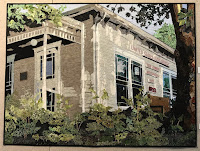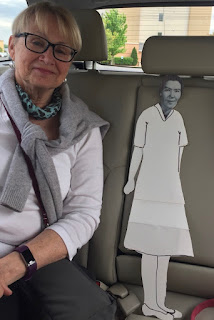Snow! A great opportunity to dye some fabric! I've used ice to dye fabric before, but never snow. Using ice or snow to dye gives vivid colors, with lots of surprises. Since I mostly use bits of fabric 6 square inches or less in my work, having fabric with lots of color/tone/shade variation is a big plus. The process is the same whether you use snow or ice, though I usually crush the ice so it is easier to pile on top of the fabric.
So the process goes like this
You'll need:
- containers with screens to keep the fabric from languishing in a puddle of muck
- Prepared for dyeing, 100% cotton
- Soda Ash
- Procion cold water, powdered dyes
- ice or snow
- rubber gloves,
- Dust mask
- goggles
Prepare your fabric for dyeing: You can purchase prepared for dyeing fabric (PFD) 100% Kona cotton, or buy regular, 100% cotton, and prepare it yourself by washing it to remove the manufacturer's sizing.
Be sensible. None of the chemicals used in dyeing will kill you, but they are they are fine powerders, and you won't want to inhale them, or get them in your eyes, and you shouldn't get the dyes or solutions on your skin. So suit up.
 Mix a solution of soda ash
Mix a solution of soda ash: Mix1 cup of powdered soda ash per gallon of water (soda ash dissolves best in warm water, 96°F. or 35°C.). The soda ash changes the pH of the fiber-reactive dyes and cellulose fibers so that the dye creates a permanent chemical bond with the fiber. (Soda ash can also be used with silk, but not other protein fibers such as wool.)
 Soak the fabric
Soak the fabric: Put the fabric in a bucket and pour enough soda ash solution over the fabric to completely immerse it. Leave the fabric to soak for at least 30 minutes. If you need to leave it for longer, no problem.
After you remove your fabric, you can save the remaining soda ash solution indefinitely. Soda ash never goes bad. Mold will not grow in it, and it does not degrade chemically. You can reuse it again and again.
Gather your containers: I use plastic shoe boxes, or buckets and push some hardware cloth down into the container. This holds the fabric above the melted snow and dissolved dyes. Since I usually mix two or three dye powders on the snow/ice, the drips underneath the hardware cloth are frequently not that beautiful, and besides, I want mottled colors that mix on the fabric.
Add the fabric: Wearing your rubber gloves, wring out the fabric, and arrange it on the hardware cloth. Loosely pleat the fabric rather than scrunching it into a ball, which will make it more difficult for the liquid dye/melted snow to penetrate all the layers.
Add the Snow:
Pile on the snow or crusshed ice. If your hardware cloth doesn't fit inside your container, make sure the fabric and snow are OVER the containers, otherwise, you'll have a huge mess to clean up.
Add the Dye: Sprinkle the dye power on top of the snow. Remember the safety-first part--goggles, dust mask, rubber gloves. Use a color wheel to help you make combinations that won't turn to gray-brown. (Two secondaries, like green and purple, pretty much make mud.)
In the containers below, on the far left I mixed cobalt blue and lemon yellow, hoping for some nice yellow-greens with bits of pure blue. Next tub over has three colors--turquoise (a blue) and fuchsia, (a red) will combine into a purple, and the third color on the right side of that tub is grape, so my hope is for nice purple-ash hues. The bucket in the back has two colors, Chinese red and deep orange. And the last tub has kelly green, lemon yellow, and deep orange--if the orange and green mix--both secondaries, I could get some mud.

Since it's been very cold--below freezin--for a couple days, I set the tubs in my barn, and let the snow slowly melt. As the snow melts, it carries the dye with it through the fabric. Here are the final results. Some are pleasing, others, meh.

In the first photo, the piece on the left was one of the ones in the cobalt and yellow tub. It's mostly very dark blue, but with some subtle greens running through. That works for me. I make a lot of fir trees so blue tending to black says firs and forests to me. The piece on the right is from the tub of green, yellow and orange. Right in the middle of that piece, where the green and orange mingled, is an ugly blob of gray-brown, but the orange and yellow combined to make some nice mottled colors, and the lower-left edge of green with some yellow made an interesting shade that says "ocean" to me.

In the second photo, the first 4 pieces were in the tub with the turquoise, fuchsia and grape. I'm happy with them. They'll work for shadows, dark parts of water and sky, mountains, foliage and who knows what else?
The green piece, was alos in the tub with the cobalt blue/lemon piece above, but obviously got more yellow dye powder. That's just what I was going for. That yellow-green is perfect for sun dappled foliage, frogs, turtles, and water.
The third photo shows pieces that were in the Chinese red and deep orange bucket. I had the middle piece of fabric scrunched too tightly, so the dye didn't penetrate that piece very well, leave a large section of blah pink. The fabric on the far right, was a piece I grabbed last minute, and it clearly isn't 100% cotton. I guess it's a blend, and got mixed in with my PFD fabrics, so it didn't react dynamically with the dye. It shall live out it's useful life as a rag.
Why do I even want fabrics like this?? Because like I said at the beginning. I use tiny snipetts of this and that to create an image. I might cut a 2-inch x 2-inch section right out of the middle of a piece of fabric if it looks like it'll be the perfect shading for a tree trunk or bird wing, a truck fender, or whatever.

































